Do you have a pear tree in your backyard with black leaves? If so, you may be wondering what is wrong with it. This is a common occurrence with pear trees, and there are a few possible explanations for why your tree may be exhibiting black leaves.
Fortunately, I’ve dealt with this problem before and I can help you figure out what might be causing your tree’s leaves to turn black. Let’s take a closer look…
Why are Pear Tree Leaves Turning black?
Fire blight, Fabraea leaf spot, and pear scab are three possible causes of black leaves on pear trees. Each of these conditions is caused by different types of fungi or bacteria, so the best way to determine which one is affecting your tree is to have it examined by a trusted expert.
Once you have an accurate diagnosis, you can take steps to treat and prevent these conditions from recurring in the future. This may involve using certain fungicides or pesticides on your tree, or simply taking a few basic measures to keep your pear tree healthy and strong.
I will now talk about each of these causes in more detail so that you can better understand the root of your tree’s black leaves problem.
1. Fire Blight
Fire blight (Erwinia amylovora) is a bacterial disease that is known to affect pears, apples, hawthorn, and other trees in the rose family. It is characterized by wilted, blackened leaves and dark cankers on branches.
It thrives in moist and humid conditions, which usually occur during the spring and early summer. The disease is dormant during the winter, so it is important to take precautions during this time by applying fungicides and other preventative measures to your pear tree.
Unfortunately, there is no cure for fire blight, so preventing the spread of the disease is your best bet. The good news is that fire blight can be kept under control with proper treatment with fungicides and other preventative measures.
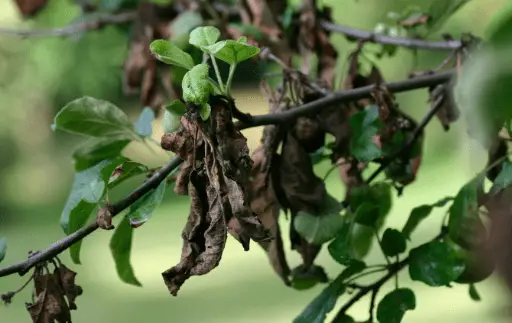
2. Pear Scab
Pear scab (Venturia pirina) is another common cause of black leaves on pear trees. You may have heard of apple scab, well pear scab is very similar. It tends to cause circular, black spots on the leaves, fruit, and even the trunk of the tree.
Like fire blight, pear scab thrives in moist and humid conditions. This makes it more likely to occur during the spring and early summer when rainfall is at its peak. To prevent this condition from affecting your tree, you may need to apply certain fungicides or pesticides on a regular basis.
Some people have had great success with companion planting, which involves planting certain flowers or herbs around the base of your tree to help keep it healthy. Planting chives around pear trees have been sometimes known to help with pear scab and other diseases.
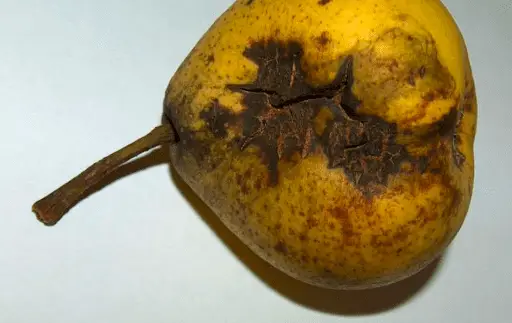
3. Fabraea Leaf Spot
Fabraea leaf spot (Fabraea maculata) is another common cause of black leaves on pear trees. This is a type of fungal disease that causes lots of tiny, black spots on the leaves of your tree. Not taking action can lead to shrinking fruit, yellow leaves, and leaf drop.
Late May and early June is the time when this condition is most likely to occur. Like the other two conditions mentioned above, it thrives in moist and humid conditions, so taking measures to keep your pear tree dry may help prevent or slow down the progression of this disease.
It’s also a good idea to prune your tree when it’s dormant to remove any dead or damaged leaves and branches. This will help prevent the spread of this condition, as well as many other diseases that affect pear trees.
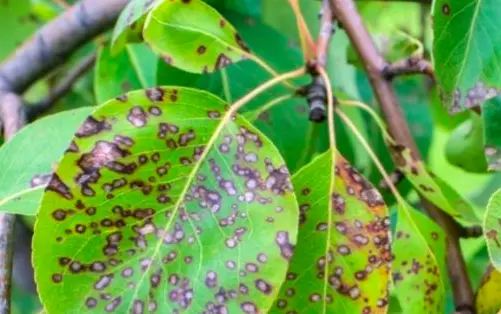
How to Treat Black Leaves on Pear Trees?
Prevention, fungicide sprays, and pruning are the top methods for treating black leaves on pear trees. Each of these methods will help to keep your tree healthy and strong, thereby reducing the risk of black leaves or other symptoms associated with various diseases.
1. Prevention
Take measures to prevent your pear tree from being exposed to moisture and humidity, which are conditions that can facilitate the growth of these diseases. For example, water your tree at the base, not from above. This will help to keep moisture off of your tree’s leaves and branches, thereby reducing the risk of black leaves or other symptoms associated with these conditions.
You can also plant pear trees that are resistant to these diseases. The following types tend not to be affected by fire blight, pear scab, and other conditions that can cause black leaves:
- Harrow Gold
- Magness
- Maxine
- Moonglow
- Harvest Queen
- Orient
- Seckel
- Harrow Crisp
- Starking Delicious
- Warren
- Kieffer
- Harrow Delight
- Harrow Sweet
- Old Home
As you can see, there are many types of pear trees that are less likely to be affected by black leaves and other symptoms associated with these conditions. So if you want to reduce the risk of your tree getting sick, consider planting one of these varieties instead.
2. Pruning
Pruning a diseased branch or leaf can also help to remove the source of infection and prevent it from spreading. Be sure to prune at the first sign of black leaves or other symptoms, before they have a chance to take hold and spread throughout your tree.
If you do decide to prune your tree, be sure to wear protective gloves, goggles, and other safety gear. This will help to prevent any harmful pathogens or spores from coming into contact with your skin.
It’s also important to disinfect your pruning equipment after you’ve used it, as this can further help to prevent the spread of disease. So be sure to clean and sanitize your tools before each use. 70% alcohol is ideal for this, as it will effectively and safely disinfect your tools.
Summer Pruning: Disease spreads quickly when the temperature is above 70ºF. This means the disease spreads quickly and violently during the warmer months. I recommend pruning 18-20 inches below where you can see any disease.
Winter Pruning: Diseases are dormant during the winter months, so it’s a good time to prune your tree. This will allow you to get rid of any infected or damaged branches, and reduce the risk of black leaves spreading throughout your tree.
The disease doesn’t spread quickly in winter, so you can prune just a few inches below where the disease starts. However, I like to err on the side of caution and prune a bit more than that, just to be sure. Remember to sanitize your tools after each use, as this will further help prevent the spread of disease.
3. Sprays
The final method for treating black leaves on pear trees is to apply sprays. These will help to kill off any pathogens or spores that may be present in your tree, thereby reducing the risk of them spreading and causing damage.
There are many different types of sprays available, from organic and natural products to chemical fungicides. So be sure to do your research, and choose the spray that is best suited for your needs.
Copper Fungicide
These are my personal favorite sprays, as they are very effective at killing off pathogens and spores. Copper fungicides can be applied regularly throughout the growing season, and are a great way to prevent black leaves from taking hold of your tree.
The exact process will depend on the exact type of spray that you use, so be sure to carefully follow the instructions provided by the manufacturer. Generally, you will need to apply the spray consistently, and at regular intervals throughout the growing season.
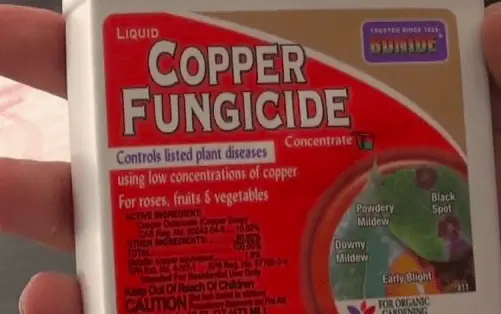
Organic Fungicide
There is a range of organic fungicides available as well, which can be a good option if you are looking for a more natural approach to dealing with black leaves on pear trees. Organic sprays often take longer to work than chemical ones, so be sure to give them plenty of time to work before you decide if they are effective or not.
I’ve had huge success with neem oil, which is a natural fungicide that kills off any pathogens or spores in my trees. It is made from the neem tree, which is native to India and known for its natural healing properties.
Another fungicide that is worth a try is vinegar. Vinegar is a natural disinfectant and antimicrobial agent, making it an ideal choice for treating black leaves on pear trees.
Here’s how to use vinegar to get rid of pear tree black leaves:
- To make a 1-gallon vinegar mixture, mix 6 cups of water with 4 cups of white vinegar
- Spray the WHOLE tree with the vinegar mixture, making sure to get all of the branches and leaves
- Repeat the process every fortnight or so, until your tree is free of black leaves and pathogens
Remember to wear protective gear like gloves and goggles when using vinegar, as it can irritate the skin if not handled properly.
There’s one more natural fungicide that you can use: essential oil. Some essential oils, like mint and cinnamon, are known for their powerful antimicrobial properties and can be a great way to get rid of black leaves on pear trees.
To use essential oil to treat black leaves, simply mix together a few drops of the essential oil with some water and spray it onto your tree’s leaves. You may need to repeat this process a few times to see results, but it is an effective and natural way to deal with pear tree black leaves.
Conclusion
In conclusion, the three most common diseases to cause black leaves are fire blight, fabraea leaf spot, and pear scab.
The good news is that there are many different methods for treating black leaves on pear trees, including pruning, sprays, and natural fungicides like copper fungicide, vinegar, and essential oil. Be sure to do your research and choose the approach that is best suited to your needs.
It’s all about protecting your tree when it is most vulnerable and taking preventative measures to keep black leaves at bay. With the right care and attention, you can enjoy a beautiful, healthy pear tree that stays free of pesky black leaves all season long!
Tim is an avid gardener from the UK. He was the founder of PlantCarer.com from 2021 to Sep 2023. He sold PlantCarer.com to Aaron. He has since started his own business called Seed To Supper, which provides new gardeners all the materials you need in a box (pots, seeds, compost and instructions) to grow your own delicious and nutritious vegetables and herbs from start to finish – no garden required.




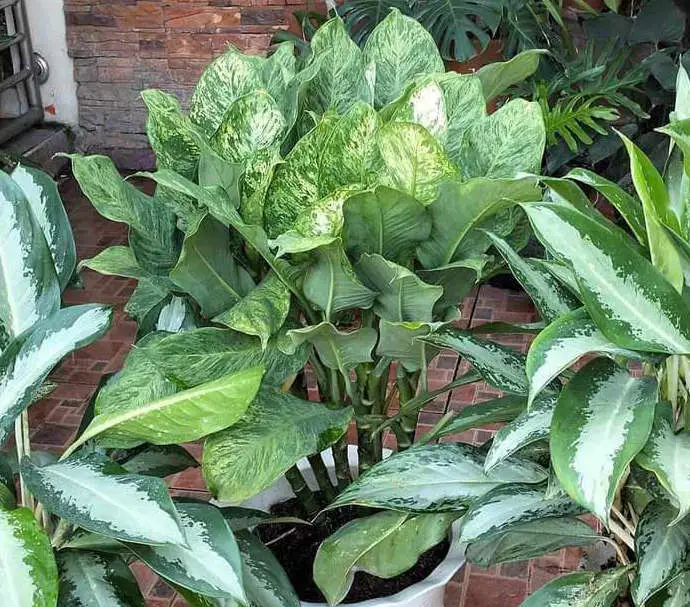

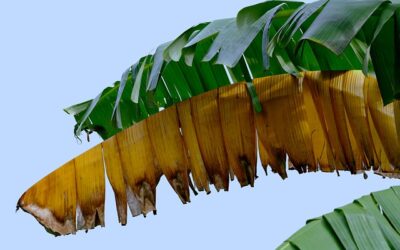
thank you for the information – gutted that I have ID d my pear tree as having fire blight – will do the vinegar remedy as recommended and hope for the best – worse case plant a different species of pear tree -d